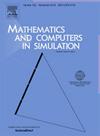Stability analysis and optimal control of tumour-immune interaction problem using fractional order derivative
IF 4.4
2区 数学
Q1 COMPUTER SCIENCE, INTERDISCIPLINARY APPLICATIONS
引用次数: 0
Abstract
In this study, we propose a tumour-immune interaction model using Caputo–Fabrizio fractional order derivative. The conditions for the well-posedness of the solution are examined. The stability of the endemic equilibrium point is derived and its stability is proved using Routh–Hurwitz criteria. The solution is approximated using a shifted Legendre polynomial at Gauss–Legendre collocation points, which is compared with the numerical results of the Adams–Bashforth scheme in the interval . We have also proposed a fractional optimal control problem and proved the necessary optimality conditions. The optimal system is solved using the forward–backward sweep method (FBSM) with the Adams–Bashforth predictor–corrector numerical method. We have demonstrated that the antigenicity of tumours plays a crucial role in activating immune cells, suggesting that enhancing tumour antigenicity could improve immunotherapeutic outcomes. The effects of fractional-order derivatives and the proliferation rate of the Michaelis–Menten term are observed. Moreover, the impact of other model parameters on the system is highlighted through numerical results. Finally, the reduction in tumour cells and the increase of active immune cells are demonstrated in the presence of optimal control.
肿瘤免疫相互作用问题的分数阶导数稳定性分析及最优控制
在这项研究中,我们提出了一个肿瘤免疫相互作用模型,使用Caputo-Fabrizio分数阶导数。研究了解的适定性条件。导出了地方性平衡点的稳定性,并用Routh-Hurwitz准则证明了其稳定性。利用移位的Legendre多项式在Gauss-Legendre配点处逼近解,并将其与Adams-Bashforth格式在区间[0,1]内的数值结果进行比较。我们还提出了一个分数最优控制问题,并证明了必要的最优性条件。采用Adams-Bashforth预测校正数值方法,采用前向-后向扫描法(FBSM)求解最优系统。我们已经证明肿瘤的抗原性在激活免疫细胞中起着至关重要的作用,这表明增强肿瘤的抗原性可以改善免疫治疗的结果。观察了分数阶导数和Michaelis-Menten项增殖速率的影响。此外,数值结果还突出了其他模型参数对系统的影响。最后,在最优控制下,肿瘤细胞的减少和活性免疫细胞的增加得到了证明。
本文章由计算机程序翻译,如有差异,请以英文原文为准。
求助全文
约1分钟内获得全文
求助全文
来源期刊

Mathematics and Computers in Simulation
数学-计算机:跨学科应用
CiteScore
8.90
自引率
4.30%
发文量
335
审稿时长
54 days
期刊介绍:
The aim of the journal is to provide an international forum for the dissemination of up-to-date information in the fields of the mathematics and computers, in particular (but not exclusively) as they apply to the dynamics of systems, their simulation and scientific computation in general. Published material ranges from short, concise research papers to more general tutorial articles.
Mathematics and Computers in Simulation, published monthly, is the official organ of IMACS, the International Association for Mathematics and Computers in Simulation (Formerly AICA). This Association, founded in 1955 and legally incorporated in 1956 is a member of FIACC (the Five International Associations Coordinating Committee), together with IFIP, IFAV, IFORS and IMEKO.
Topics covered by the journal include mathematical tools in:
•The foundations of systems modelling
•Numerical analysis and the development of algorithms for simulation
They also include considerations about computer hardware for simulation and about special software and compilers.
The journal also publishes articles concerned with specific applications of modelling and simulation in science and engineering, with relevant applied mathematics, the general philosophy of systems simulation, and their impact on disciplinary and interdisciplinary research.
The journal includes a Book Review section -- and a "News on IMACS" section that contains a Calendar of future Conferences/Events and other information about the Association.
 求助内容:
求助内容: 应助结果提醒方式:
应助结果提醒方式:


